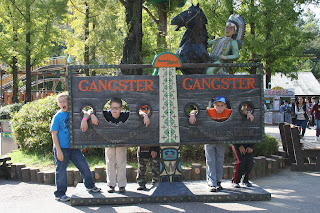 |
| Injeongjeon, the main hall. |
Changdeokgung Palace was the second royal villa built following the construction
of Gyeongbukgung Palace in 1405. It was the principal palace for many of the
Joseon kings and is the most well-preserved of the five remaining royal Joseon
palaces. During the tour of the palace grounds you can see the public palace area, the royal
family residence building, and the rear garden (known as the Secret Garden, Huwon). The garden was a place of rest for the
kings, and boasts a gigantic tree that is over 300 years old, a
small pond, and a pavilion.
The palace was burned by fire in 1592, but restored in 1611. It became a World Heritage site in 1997.
It was a very interesting tour for me as this palace had both public and royal areas. You could clearly see the difference between the two areas. The non-royal areas were very plain compared to the royal buildings with all their paint and detail work. The garden was also amazing. A very natural wilderness area that provided a private setting for the king and his family to relax; be one with nature. We went at the end of fall colors so didn't catch it in its full glory. It was still a beautiful sight. I can imagine it was a very dear place for the royal family.
 |
| Throne of the king in Injeongjeon. |
 |
| Ceiling detail work in Injeongjeon. |
 |
| Dampers in a chimney. |
 |
| A non-royal building in the palace. Notice the lack of color and detail. |
 |
| One of the gates in Changdeokgung. |
 |
| Tile work on the palace walls. |
 |
| Buildings were elevated like this one so that during the winter they had heated floors (Ondol). |
 |
| Roof lines of the palace grounds. |
 |
| Small pavilion on Buyongji pond. |
The Buyongji (34.5m by 29.4m) is a rectangular pond with a round island in the center in the secret garden. The island is 9 meter in diameter. It was built in 1707. The king and his family would come to fish, relax, and learn here in the garden area.
http://jikimi.cha.go.kr/english/royal_palaces_new/Changdeokgung.jsp?mc=EN_05_01_01















































